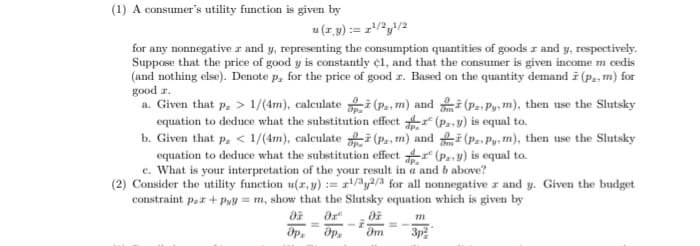(1) A consumer's utility function is given by u (z_y) := z/2y/2 for any nonnegative z and y, representing the consumption quantities of goods z and y, respectively. Suppose that the price of good y is constantly ¢1, and that the consumer is given income m cedis (and nothing else). Denote p, for the price of good z. Based on the quantity demandi (p., m) for good z. a. Given that p, > 1/(4m), calculate i (P.. m) and i (p.- Py. m), then use the Slutsky equation to deduce what the substitution effect r (P.-y) is equal to. b. Given that p, < 1/(4m), calculate (Pa. m) and i(P.-Py.m), then use the Slutsky equation to deduce what the substitution effect +r (P.-y) is equal to. c. What is your interpretation of the your result in a and b above? (2) Consider the utility function u(z, y) := z/aya/3 for all nonnegative z and y. Given the budget constraint p.r+ Pvy = m, show that the Slutsky equation which is given by dp, Op, 3p
(1) A consumer's utility function is given by u (z_y) := z/2y/2 for any nonnegative z and y, representing the consumption quantities of goods z and y, respectively. Suppose that the price of good y is constantly ¢1, and that the consumer is given income m cedis (and nothing else). Denote p, for the price of good z. Based on the quantity demandi (p., m) for good z. a. Given that p, > 1/(4m), calculate i (P.. m) and i (p.- Py. m), then use the Slutsky equation to deduce what the substitution effect r (P.-y) is equal to. b. Given that p, < 1/(4m), calculate (Pa. m) and i(P.-Py.m), then use the Slutsky equation to deduce what the substitution effect +r (P.-y) is equal to. c. What is your interpretation of the your result in a and b above? (2) Consider the utility function u(z, y) := z/aya/3 for all nonnegative z and y. Given the budget constraint p.r+ Pvy = m, show that the Slutsky equation which is given by dp, Op, 3p
Chapter4: Utility Maximization And Choice
Section: Chapter Questions
Problem 4.11P
Related questions
Question

Transcribed Image Text:(1) A consumer's utility function is given by
u (z.y) := z/2y/2
for any nonnegative r and y, representing the consumption quantities of goods z and y, respectively.
Suppose that the price of good y is constantly ¢1, and that the consumer is given income m cedis
(and nothing else). Denote p, for the price of good z. Based on the quantity demand i (p., m) for
good z.
a. Given that p, > 1/(4m), calculate i (P., m) and i (Pa- Py, m), then use the Slutsky
equation to deduce what the substitution effect r (P..y) is equal to.
b. Given that p, < 1/(4m), calculate i (P., m) and i (P.- Py: m), then use the Slutsky
equation to deduce what the substitution effect r (P.-y) is equal to.
c. What is your interpretation of the your result in a and b above?
(2) Consider the utility function u(r, y) := r/y2/3 for all nonnegative z and y. Given the budget
constraint par + Pyy = m, show that the Slutsky equation which is given by
3p
Expert Solution
This question has been solved!
Explore an expertly crafted, step-by-step solution for a thorough understanding of key concepts.
This is a popular solution!
Trending now
This is a popular solution!
Step by step
Solved in 2 steps

Knowledge Booster
Learn more about
Need a deep-dive on the concept behind this application? Look no further. Learn more about this topic, economics and related others by exploring similar questions and additional content below.Recommended textbooks for you

